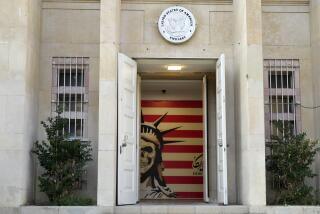Archeologists Dig Up History on Cloister
- Share via
EPHRATA, Pa. — The Ephrata Cloister is painted in history as an austere religious community that shunned European ways.
Excavators are now digging up a different view.
For one thing, a butchered deer leg bone indicates the members ate meat.
“These people were not the absolute vegetarians they were made out to be,” said archeologist Stephen G. Warfel, leader of an excavation in Lancaster County where the radical 18th-Century cloister lived.
The $30,000 project, funded by the Pennsylvania Historical and Museum Commission and Pennsylvania State University, aims to learn more about the religious order that farmed, tanned leather, wrote hymns and made ornate wall hangings along the banks of Cocalico Creek.
It was founded in 1732 by Conrad Beissel, a German who fled religious persecution and was drawn to the tolerance preached by Pennsylvania’s founder, William Penn. Penn was a Quaker, a sect that also was persecuted in Europe.
Much is known about the cloister, which included families and celibate men and women. The members wore white, hooded cloaks and lived contemplative lives devoted to religious worship.
They produced more than 1,000 hymns, which were sung in four- and five-part harmony without accompaniment, and offered some of the finest printing services of the day.
Among their clients were the Mennonites, who hired Ephrata printers to translate and print Martyrs’ Mirror, a chronicle of Mennonite persecution. At 1,500 pages, the book was the longest printed in Colonial America.
But a community’s remains often reveal more truth than written records, said Warfel, a senior curator with the State Museum of Pennsylvania.
“Trash is sort of a democratic record,” he said. “Documents are written for a purpose. What we find in the ground is what they actually did.”
Records indicate members ate a diet of nuts, bread, apples, pumpkin mush and barley boiled in milk. But the deer bone shows the diet included at least some meat.
Another indication that life wasn’t as austere as historians have believed are several pieces of excavated delftware, white and blue ceramics made in England and the Netherlands that were popular in the early 18th Century.
The excavation focused on exploring a small depression--no more than two feet deep at its center.
Using hand troughs and dirt sifters, archeology students combed for artifacts as small as glass shards and old hooks and eyes from garments.
“It gets frustrating, especially when you’re going through rock like this,” said Lisa Lauria, 20, an Oberlin College junior. “But it’s very rewarding, especially when you find something.”
Discovered by accident five years ago when lines were being laid for a fire-sprinkler system, the depression is believed to be the site of a solitary cabin built in the cloister’s early days before communal housing.
More to Read
Sign up for Essential California
The most important California stories and recommendations in your inbox every morning.
You may occasionally receive promotional content from the Los Angeles Times.












